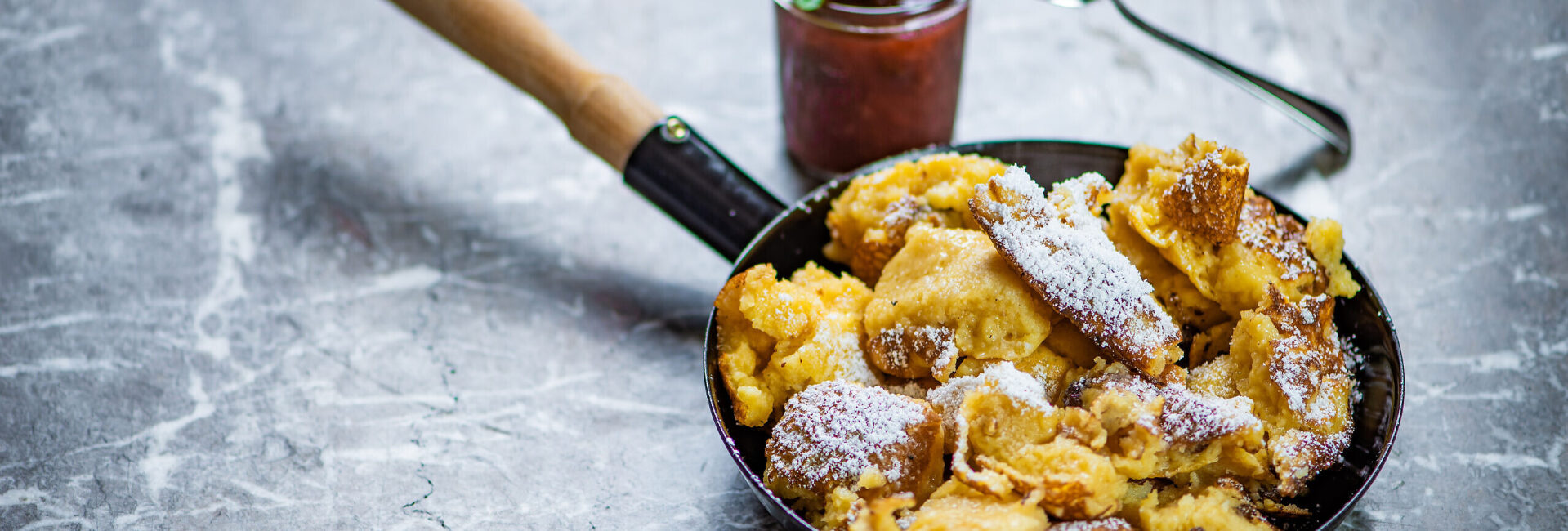Kaiserschmarren is one of the most famous desserts of Austrian cuisine. The recipe, lots of info and a cooking video about this classic can be found this time on Steinerwirt’s blog:
History and origin of the scab
Schmarren – a simple dish made of milk, eggs, flour and salt – has been known for centuries as a simple peasant dish. A Schmarren is first mentioned in literature in 1563 in the wedding sermon of the German theologian Johannes Mathesius, which speaks of a “feisty” Schmarren. At 18th century, the Schmarren was adopted by the urban-bourgeois cuisine, refined and thus made “presentable”. Furthermore, the dishes that are today synonymous with Viennese cuisine such as “Kaiserschmarren mit Zwetschkenröster” or “Mehlschmarren”, “Semolinaschmarren” and “Semmelschmarren” were created. Historians assume that the “Kaiserschmarren” originated from the word “Kaser”, derived from “Casa” (Casaschmarren = house pancake), which means “alpine dairyman” and in the course of time became “Kaiserschmarren” and has its origin in the southern Alpine region. Nevertheless, this dish expresses prosperity, since sugar and white flour in earlier times was a sign of wealth and was reserved for the higher rulers. The term “emperor” for courts was used in the 19th century by Austrian chefs when it was necessary to distinguish dishes and special goodness (eg, Kaisersemmel, Kaiserfleisch).
Legends around the Kaiserschmarren
The history of the Kaiserschmarren is associated in several legends with the Austrian imperial family and is probably due to Emperor Franz Joseph I (1830 – 1916).The emperor is said to have been served a Holzfällerschmarren during one of his hunting trips in the Salzkammergut. This was refined in his honor with good ingredients such as milk, raisins and eggs. Thus, an ordinary woodcutter’s pancake became a distinguished emperor’s pancake. Another legend is that the court chef once found the dough of the pancake too thick and tore it. The emperor then sent back his dessert with the words, “Such trash is not worthy of the emperor!” So the misshapen pancake was not good enough to be served to His Highness – at least that’s the legend. Other sources claim that Kaiserschmarren was actually originally “Kaiserinschmarren”, as it was created by Viennese chefs for Empress Elisabeth in 1854. But Empress Elisabeth (“Sisi”), always mindful of her lineage, found it less pleasing than her husband Emperor Franz Joseph I, and so it became “Kaiserschmarren”. Another story tells the following: Franz Joseph loved Bad Ischl and was there as often as possible. The imperial family made the city hopeful by their presence. During one of the high couple’s stays in Ischl, the imperial and royal chef came up with something new and light for the empress. Knowing that Sisi had problems with her teeth, he cooked a schmarren. He copied a simple dessert made of flour, milk and eggs that was popular in Upper Austria, the “Kaserschmarren”. He refined the dish with raisins and served it as a dessert. The emperor did not understand the name very well and said that the cook had named the new flour dish “Kaiserschmarren” in his honor. Sisi is said not to have liked the Schmarren very much because of the raisins.
Ingredients (2 servings)
3 eggs
250 ml milk
120 g wheat flour smooth
30 g granulated sugar
50 g raisins
40 g butter
1 cl rum
Powdered sugar
Preparation
Heat oven to 280 degrees. Mix milk, flour, granulated sugar and rum well with a hand blender. Then add the eggs and mix briefly. Heat the butter in a pan on the stove. Briefly fry the raisins in the hot fat, then add the mixture to the pan and sauté for approx. 30 s. Bake the Kaiserschmarren in the oven for about 4 min until it is golden and rises in the pan, that is, lifts in the pan. Now turn the dough in the pan and sprinkle with some granulated sugar (tip from the pro: turning is easier if you cut the dough in the pan into 2 parts beforehand). After that, the dough is baked again in the oven for about 4 min. Finally, “tear” the Kaiserschmarren into small pieces in the pan, arrange on the plate and sprinkle with powdered sugar. Kaiserschmarren is classically served with stewed plums, but applesauce or pear compotes also go well with it.
